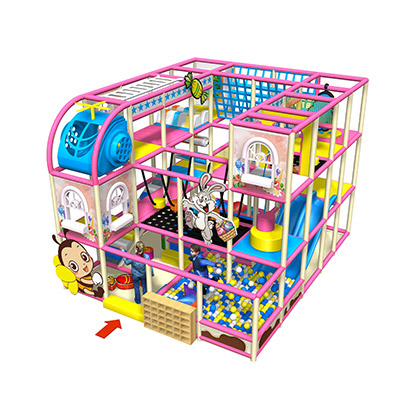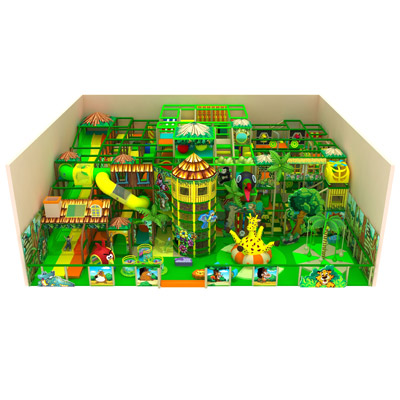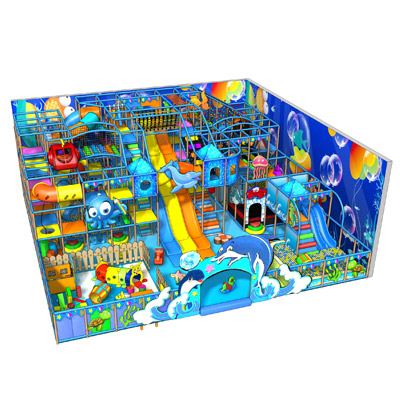How to Design a Mall Playground?
A careful and creative approach is needed when designing a playground for a mall in order to produce a space that meets the varied demands and preferences of kids and blends in with the overall aesthetic of the shopping center. So, how to design a mall playground in the shopping center? A well-thought-out mall playground is more than just a place to hang out; it's a vibrant, stimulating space that makes shopping for families more enjoyable as a whole. We created a guide to designing a mall playground to give you the best output for your next project.

What You Should Consider Before Designing Mall Playgrounds
1. Understanding Space and Layout
Planning a playground for a shopping center requires a thorough evaluation of the available space. It is important to think about how best to utilize available space while making sure that the design allows for easy access and traffic flow. Play areas should be thoughtfully positioned to enhance the overall mall atmosphere and promote exploration. Including places for parents and guardians to sit and unobstructed sightlines makes the experience safer and more interesting.
●Assessment of Available Area
●Traffic Flow and Accessibility Considerations
2. Safety Regulations and Compliance
When designing playgrounds in shopping centers, adherence to safety rules is crucial. It is essential to adhere to the standards established by agencies such as the Consumer Product Safety Commission (CPSC) and the American Society for Testing and Materials (ASTM). To reduce dangers and provide a safe atmosphere for kids, safety measures like rounded edges on equipment, soft flooring materials, and the right amount of space between structures should be included.
3. Target Audience and Theme
Developing a successful mall playground requires a thorough understanding of the target audience. A wide range of developmental needs are met by the play area thanks to consideration for various age groups. A theme can also provide excitement and consistency to the entire design, making the indoor playground more appealing to the eye and memorable for young visitors. Some themes include nature-inspired, adventure-based, or fantasy-based.
4. Selection of Play Equipment
A). Types of Indoor Playground Equipment
For kids of various ages and developmental stages, each of these indoor playground equipment types promotes physical activity, social interaction, and imaginative play, all of which add to a well-rounded play experience. Design considerations are essential in guaranteeing that these components are not just.
1.Swings
Swings are a timeless and beloved playground feature that is made up of seats suspended from chains or ropes. Kids take pleasure in the energizing back-and-forth motion, which fosters a feeling of liberty and happiness.

2.Slides
Children are meant to slide down inclined surfaces called slides. They come in a range of sizes and forms and provide differing levels of thrill. For extra fun, some slides might have bumps, twists, or other features like turns.

3.Climbing structures
Platforms, ladders, and structures with climbing components like nets or walls are examples of climbing structures. They improve coordination, promote physical activity, and give kids a sense of accomplishment as they overcome obstacles.

4.ball pits
Use ball pits to land safely and softly. With the peace of mind these safe havens offer, you can push yourself to the edge with reckless abandon.

5.Mini City play role house
Mini City play role house are tiny, house-like constructions that sometimes have extra features like slides or climbing areas in addition to doors and windows. They offer an area for creative and role-playing exercises.

B) Trampoline Park Equipment
The equipment is a major contributor to the exhilarating environment that trampoline parks provide. The trampoline: the park's central feature! Classic open jump arenas are available, as well as specialty areas such as basketball hoop trampolines for slam dunks, dodgeball courts for friendly competition, high-performance trampolines for advanced moves, dedicated trampoline parkour areas for freestyle flow, and even tumble lanes for gymnastic practice. Get ready to jump through the main trampoline attraction:
1. Trampoline
Make thrilling leaps to challenge gravity and soar to new heights! Whether you're practicing flips or just bouncing around for fun, feel the weightlessness and the sheer thrill of flight.

2. Safety Padding (foam pit, inflatable airbag, etc)
Use supple padding, such as an inflating airbag or a foam pit, to land safely and softly. With the peace of mind these safe havens offer, you can push yourself to the edge with reckless abandon.

3. Wipeout Trampoline
Put your friends and yourself to the test with this funny game. In a fit of laughing, test your agility and coordination while bouncing, sliding, and dodging rotating objects. Hold on tight.

4. Reaction Wall
Test your reflexes with the Reaction Wall, an interactive tool. Unpredictably fast flashing lights necessitate lightning-fast movements and quick reactions. Are you able to continue the challenge?

5. Climbing wall
On the exhilarating Climbing Wall, reach new heights and face your worries. You can chart your progress with the help of well-placed handholds and footholds, which gives you a satisfying sense of achievement when you reach the top.

C) Ninja Warrior Course Equipment
Some of the Obstacle Elements:
Cargo nets
Participants climb through a grid formed by woven ropes or webbing, which is known as a cargo net. They offer an exciting and demanding climbing experience.
Warped walls
Participants must sprint up inclining walls, or "warped walls," to reach the top. They measure coordination, strength, and speed.

Flying rings
Participants must swing back and forth between flying rings, which are suspended from overhead structures. Their grasping ability and coordination are put to the test.
5. Understanding the Budgeting and Cost To Design a Mall Playground
Equipment Costs
The costs of buying the different parts and structures that comprise the playground are included in the equipment costs. This covers any specialized Ninja Warrior course components as well as swings, slides, climbing frames, and trampolines. Depending on the kind, caliber, and manufacturer of equipment selected for the design, the prices may change.
Installation Expenses
The cost of the labor, supplies, and equipment required to set up the playground is covered by installation expenses. This covers clearing the area, putting the machinery together, adding safety features, and doing any necessary groundwork or landscaping. Site preparation and professional installation

Maintenance and Operational Costs
The continuous costs involved in maintaining the playground's quality and guaranteeing its smooth operation are referred to as maintenance and operational costs. This covers routine staffing, cleaning, repairs, and inspections.
Long-term Viability and Durability of Design
Evaluating the design's long-term viability and durability entails determining how well it will hold up over time in the face of shifting trends and usage patterns. A well-planned design can lessen the need for regular renovations or updates. Some points you need to consider are material quality, user feedback, adaptability, etc.
Aesthetics and Theming to Align with Mall Branding
Incorporating a playground into a mall requires careful consideration of the overall design and theming to match the mall's branding. The playground's style and color palette should blend in with the mall's overall aesthetic to create a unified and welcoming environment. A cohesive and pleasurable mall experience is facilitated by the enhancement of the entire space's appearance and feel through consistent branding.
Seating Areas for Parents and Caregivers
A successful integration of a mall playground requires an understanding of the needs of parents and other caregivers. Incorporating cozy and well-positioned seating sections close to the playground enables parents to keep an eye on their kids while simultaneously offering a handy spot to relax. A good overall experience is enhanced by comfortable seating, which entices families to spend more time at the mall.
Signage and Wayfinding for Easy Navigation
To guarantee simple navigation within the playground area of the mall, effective signage and wayfinding components are essential. Age-appropriate zones, crucial safety instructions, and the playground's location should all be marked with prominent signage. What are the criteria for mall design? Clearing up any confusion and encouraging visitors to feel safe and accessible, improves the user experience. The mall's environment is made more pleasant and user-friendly by well-designed wayfinding features.
6. How to Find a Reliable Supplier for the Mall Playground
To find possible suppliers, start by doing extensive research. Make use of trade exhibits, industry directories, and internet resources to compile a list of vendors that specialize in playground equipment. Take into account elements like their range of products, experience, and reputation.
Check possible suppliers' credentials to make sure they are reliable. Are they meeting standards for quality and safety and should be followed by a reliable supplier? Check past customer service, delivery schedules, and product quality. You can evaluate the products' quality, durability, and design directly by looking at real samples. To learn more about the supplier's production methods, try to visit their manufacturing sites.
Conclusion
Through this article, you are now able to understand how to design a mall Playground. If you are looking for a reliable mall playground equipment supplier for your next project then Dreamland Playground creates incredible ninja warrior experiences. With our top-notch equipment, you can create a course that is both safe and exhilarating, making it ideal for thrill-seekers, families, and fitness fanatics.
We specialize in creating amazing adventures rather than merely trampoline parks. Let your creativity run wild and get in touch with us right now to design the playground of your desires!











